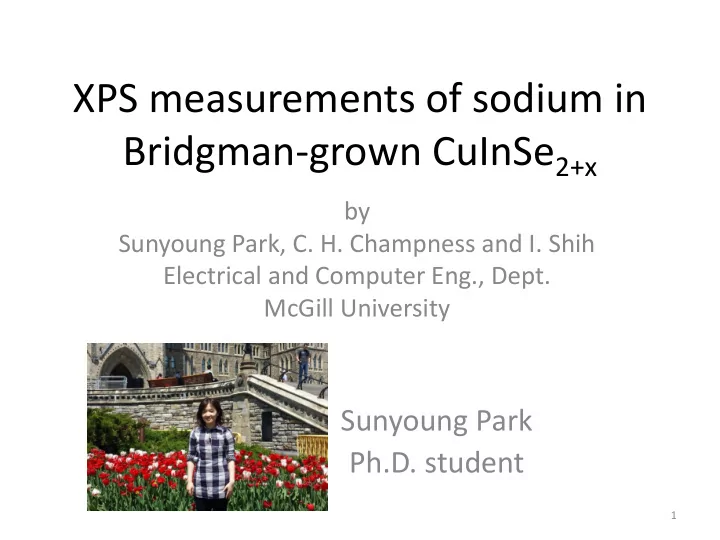

XPS measurements of sodium in Bridgman-grown CuInSe 2+x by Sunyoung Park, C. H. Champness and I. Shih Electrical and Computer Eng., Dept. McGill University Sunyoung Park Ph.D. student 1
J-V characteristics under simulated AM 1.5 conditions of a Cu(In,Ga)Se and a CuInSe 2 cell. The cells are AR-coated. Cell temperature is 25 °C (Hedstrom and Ohlsen, 1993) h ν h ν Metal grid evap. ZnO cond ZnO cond Sputtered ZnO i ZnO i Solution grown n CdS n CdS (50 nm) p CuInSe 2 p Cu(In,Ga)Se 2 2 µm Mo Mo Sputtered Glass substrate Glass substrate 2 Earlier cell Later cell
Solar cell efficiency with added Na 2 Se (Nakada and Ohbo, 1997) 3
A quartz ampoule with Cu, In, Se, and Na Se In Cu Na 4
Bridgman Growth Apparatus 5
Bridgman-grown ingot 6
Bridgman-grown ingot CuInSe 2+x n-type If [Na]>[Na] crit =2x+ δ 7
Before abrasion 60 Relative Percentage (%) 50 Cu 40 Se 30 In 20 10 0 0 50 100 150 Ar etching (s) 8
After abrasion 45 Relative Percentage (%) Se 40 35 Cu 30 In 25 20 15 10 5 0 0 20 40 60 80 100 Ar etching (s) 9
XPS survey scans for different locations of an ingot Na1s In3d O1s cylindrical Cu2p3 surface of ingot Se3d Counts/s In3d Cu2p3 interior of ingot Se3d 1000 500 0 Binding Energy (eV) 10
Na1s scan cylindrical surface of Counts/s ingot interior of ingot 1080 1075 1070 1065 1060 Binding Energy (eV) 11
Na1s scan HMB56 (3 at. % Na) curved 60 Atomic percentage (%) In 50 40 Se 30 20 Cu 10 Na 0 0 50 100 150 200 Ar ion etching time (s) 12
[Cu] surf vs. [Na] surf 30 At. % of Cu at surface (of 3 elements Cu, In, Se) 25 Bulk n-type 20 Bulk p-type 15 10 5 0 0 20 40 60 80 100 Na at. % (of 4 elements) at surface 13
[Cu] surf vs. [Na] melt 30 At. % of Cu at surface (of 3 elements Cu, In, Se) 25 Bulk n-type 20 Bulk p-type 15 10 5 0 0 2 4 6 Na at. % (of CuInSe2) in melt 14
[Se] surf vs. [Na] sulf 80 At. % of Se at surface (of 3 70 elements Cu, In, Se) 60 Bulk n-type 50 Bulk p-type 40 30 20 10 0 0 20 40 60 80 100 Na at. % (of 4 elements) at surface 15
Conclusions • The present results in Bridgman-grown CuInSe 2+x demonstrate that: • (1) The main variations in ternary composition occur in the first 100 nm from the ingot surface, even without Na addition. • (2) With increase of up to about 1 at. % of added elemental Na to the melt, the relative surface concentration of Cu is decreased and that of Se, in p-type (bulk) material, is increased. • (3) The Na is mostly present in a 0.2 micron surface layer and none is detected by XPS in the bulk. • (4) The reduction of Cu proportion at the surface occurs with and without added Na but is accentuated with up to 1 at. % of added Na in the melt. • (5) Some of the XPS results may have been affected by the abundant carbon present. • (6) For samples exposed to air, the addition of Na gives rise to the extra compounds CuSe 2 , Na 2 SeO 4 , and Na 2 SeO 3 , at least at the surface. 16
Speculation CdS Lower recombination interface interface h ν CuInSe 2 Low Cu or CdS Ternary Cu(InGa)Se 2 n p Low Cu ternary/CuInSe 2 n/p interface The End 17
The End 18
Recommend
More recommend